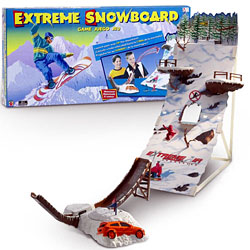Extreme Snowboard Game
Snowboarding Game
 Extreme Snowboard is the only game where kids can live out the fantasy of snowboarding all year long. Use the power ramp launcher to launch a snowboarder onto the 3-D mountain and score points. The more difficult the landing, the more points you score. Kids take turns launching their plastic snowboarders at the face of a hazard-strewn mountain, scoring points (or not) depending on where their guys end up. Land on a ledge? You've got points. Land in a tree? You've got trouble. These dudes really fly, and testers loved honing their aim and watching the spectacular wipeouts.
Extreme Snowboard is the only game where kids can live out the fantasy of snowboarding all year long. Use the power ramp launcher to launch a snowboarder onto the 3-D mountain and score points. The more difficult the landing, the more points you score. Kids take turns launching their plastic snowboarders at the face of a hazard-strewn mountain, scoring points (or not) depending on where their guys end up. Land on a ledge? You've got points. Land in a tree? You've got trouble. These dudes really fly, and testers loved honing their aim and watching the spectacular wipeouts.
History of Snowboarding
Snowboarding, a popular winter sport that combines elements of skiing and surfing, has a rich and evolving history that traces back several decades. The sport's journey from its humble beginnings to becoming a global phenomenon is a testament to innovation, creativity, and the passion of its enthusiasts.
1960s and 1970s: The Early Years
The origins of snowboarding can be traced back to the 1960s, when individuals began experimenting with riding boards on snow. In the 1960s, Sherman Poppen created the "Snurfer," a rudimentary snowboard with a rope attached to the front for control. The Snurfer gained popularity as a toy, sparking interest in snowboarding as a recreational activity.
1980s: Rise of the Modern Snowboard
The 1980s marked a turning point for snowboarding, as advancements in design and technology transformed it into a legitimate sport. Jake Burton Carpenter, often referred to as the "father of snowboarding," played a pivotal role in developing modern snowboards. He founded Burton Snowboards in 1977 and worked to refine board shapes, bindings, and materials.
Despite initial resistance from ski resorts, snowboarding gained traction and recognition. The first National Snow Surfing Championship was held in 1982, and the FIS (Fédération Internationale de Ski) recognized snowboarding as an official sport in 1985. Snowboarders were no longer seen as outsiders; they had established a unique subculture and community of their own.
1990s: Mainstream Recognition
The 1990s marked the widespread acceptance and integration of snowboarding into winter sports culture. Major ski resorts began allowing snowboarders on their slopes, and snowboarding events were added to the Winter X Games. Snowboarding made its debut at the 1998 Winter Olympics in Nagano, Japan, further cementing its status as a mainstream sport.
2000s and Beyond: Evolution and Innovation
The 21st century brought continued innovation to snowboarding, with advancements in board shapes, bindings, and technologies. Freestyle and freeride snowboarding gained popularity, leading to the development of specialized boards for different riding styles. The sport also expanded to include terrain parks, halfpipes, and backcountry riding.
Professional snowboarders became household names, and snowboarding culture influenced fashion, music, and art. The sport embraced diversity, with riders of all backgrounds and ages participating in competitions and events around the world.
Today, snowboarding continues to evolve with a focus on sustainability, inclusivity, and pushing the boundaries of what's possible on the snow. It remains a dynamic and exciting sport that captures the spirit of adventure and creativity that fueled its early days.
The history of snowboarding is a testament to the passion and determination of those who pioneered the sport, transforming it from a backyard experiment to an international phenomenon enjoyed by millions of enthusiasts worldwide.
